Nana was eight years old when we were drawn to play each other in round two. She was ill, her nose was swollen red and her eyes were watering badly. It was a bad cold, probably caused by the catastrophic conditions at site. Verdun was my second European Championship participation, and unlike the first, the participants were not provided with accommodation. They just got a communal sports hall for overnight stays. Nowadays, that can best be compared to a refugee camp, but in the 90s it was not uncommon.
The German delegation decided to look for alternative accommodation, on the first day, and quickly found something. The Georgians were probably not so lucky or did not have the financial means to do the same.
Anyway, I soon noticed that my game against Nana was slipping away from me, and in my desperation I offered my young opponent a draw, contrary to the usual rule, because it was my turn. But Nana was already super smart – at the age of eight! – and demanded that I should execute my move first.
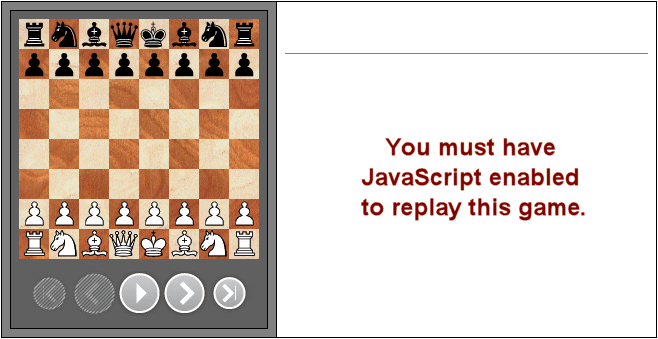
[Event "EU-ch U10 Girls"] [Site "Verdun"] [Date "1995.??.??"] [Round "2"] [White "Dzagnidze, Nana"] [Black "Paehtz, Elisabeth"] [Result "1/2-1/2"] [ECO "B26"] [Annotator "Paehtz,Elisabeth"] [SetUp "1"] [FEN "8/3N1pk1/b1n1p1p1/7p/2q1PP2/1p4PP/1P1Q2B1/7K w - - 0 33"] [PlyCount "2"] [EventDate "1995.??.??"] [EventType "swiss"] [EventRounds "9"] [EventCountry "FRA"] [SourceTitle "EXT 1997"] [Source "ChessBase"] [SourceDate "1996.11.15"] [SourceVersion "1"] [SourceVersionDate "1996.11.15"] [SourceQuality "1"] {Let's take a look together at the position - a look is worth a thousand words. Position after} 33. Qd6 {Nana threatened to continue with an ugly check on f8 followed by a knight mate on f6. The only way to defend this was to sacrifice my queen on b4. Unfortunately, I understood that at that time. I tried to convince my opponent to forget about my executing a move, by offering the draws ten times in a row. Even Nana's mum, who was watching the action together with my father in the audience at that time, was as caring as a mum can be and made it clear to Nana that a draw was a good decision. My father, who is a grandmaster, was also clearly in favour of this idea. Unlike Nana's worried mum, he concentrated exclusively on the chess and not the health issues at this moment. And of course he realized how bad things were for me. Nana nevertheless remained steadfast and refused. I thought and thought and thought. On the one hand, I knew that I would be checkmated after Qc1+ followed by Qxb2 after e4-e5. On the other hand, I couldn't imagine that my opponent would accept my offer of a draw after any move that resulted in a piece loss. After 20 minutes thinking about the consequences of my next move, I finally decided on the "correct" Qc1+ and was visibly relieved when Nana's stretched out her hand to accept the draw.} Qc1+ {Draw accepted.} (33... Qc1+ 34. Kh2 Qxb2 35. e5 ({or} 35. Qf8+ Kh7 36. e5 {with mate to follow.})) 1/2-1/2
GM Nana Dzagnidze
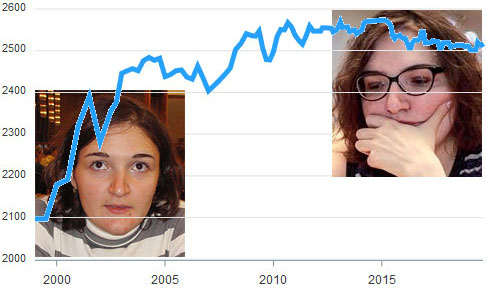 Nana was a New Year's child: she was born on January 1st 1987. Her father, a big chess fan, named her after the famous Georgian chess player Nana Alexsandria. Little Nana learnt chess at the age of five, and her first international success was becoming the European Champion of girls under ten, in Talin in 1997. After that she became the U12, U16, U18 and U20 world champion, and won the European Championship on several occasions. "I think my biggest successes in chess," says Nana, "were when my I and my Georgian Team won the Chess Olympiad in Dresden in 2008, when I became World Blitz Champion in Riyadh in 2017, and became European Women's Individual Champion in 2017. I have also twice won the FIDE Womens Grand Prix, in Jermuk in 2010, and then in Lausanne this year."
Nana was a New Year's child: she was born on January 1st 1987. Her father, a big chess fan, named her after the famous Georgian chess player Nana Alexsandria. Little Nana learnt chess at the age of five, and her first international success was becoming the European Champion of girls under ten, in Talin in 1997. After that she became the U12, U16, U18 and U20 world champion, and won the European Championship on several occasions. "I think my biggest successes in chess," says Nana, "were when my I and my Georgian Team won the Chess Olympiad in Dresden in 2008, when I became World Blitz Champion in Riyadh in 2017, and became European Women's Individual Champion in 2017. I have also twice won the FIDE Womens Grand Prix, in Jermuk in 2010, and then in Lausanne this year."
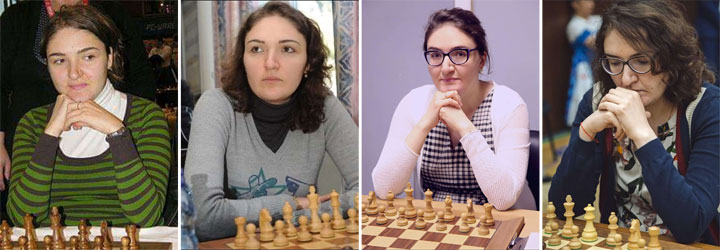
Over the years: Nana Dzagnidze at 21, 22, 29 and today.
Nana gained the full grandmaster title in 2008, after she scored 7/10 points at the Chess Olympiad. In 2017 she became the women's individual champion in Riga. At the Gibraltar Chess Festival, she won the prize for the best female player in 2009 and 2011. In 2017 she received the honorary FIDE award of Caissa as the best female player of the year.
In July 2010 Nana won the fourth leg of the FIDE Women's Grand Prix series in Jermuk, scoring +7 =4 and finishing 1½ points ahead of second-place player. This is the standing in the current Grand Prix:
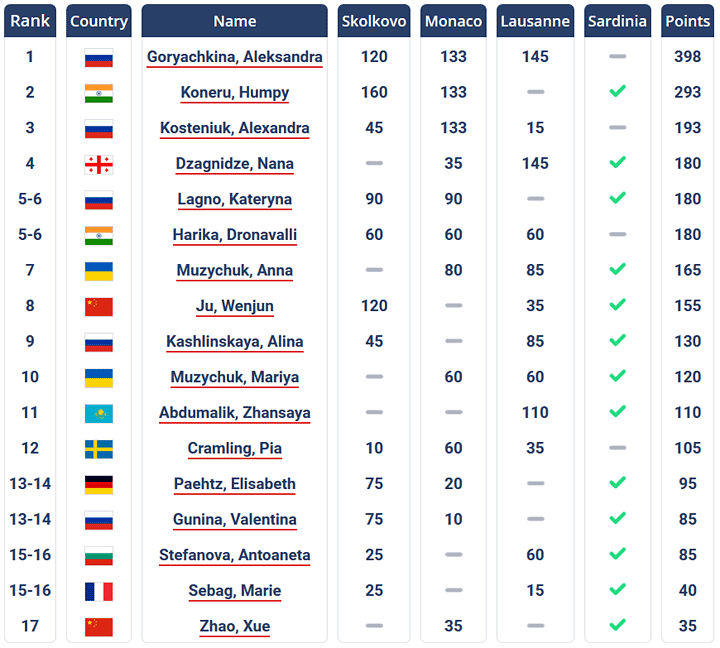
Nana has outstanding chances to qualify for the next Candidate Tournament, as her only main rivals are Anna Muzychuk, Katja Lagno and Alina Kashlinskaya. Harika and Sasha Kosteniuk have finished their series, so they are not able to collect any further points, while Aleksandra Goryachkina is already seeded to the Candidates, as she was the runner-up of the previous Women's World chess Championship. Eventually Nana finishing ahead of any of the rivals mentioned above would give her the spot in the next candidates tournament.

[Event "GP Lausanne"] [Site "?"] [Date "2020.03.11"] [Round "?"] [White "Ju, Wenjun"] [Black "Dzagnidze, Nana"] [Result "0-1"] [ECO "D36"] [Annotator "Eli Pähtz"] [PlyCount "164"] {Knowing Nana I would say that this game that brought her into the sole lead with just two more rounds to go was the final point to convince herself that she could really win this tournament.”} 1. d4 Nf6 2. c4 e6 3. Nf3 d5 4. Nc3 c6 {a bit surprising as Dzagnidzes main weapon is the Nimzoindian defense. Yet I think this structure suits her style perfectly, which relies in a great mixture of dynamic and tactical play.} 5. Bg5 Nbd7 $5 {A bit astonished by this decision as I would have bet on either the Moscow or Botvinnik system.} 6. cxd5 ({one of the main lines follows after} 6. e3 Qa5 7. Nd2 Bb4 8. Qc2 O-O 9. Be2 (9. a3 dxc4 10. Bxf6 Nxf6 11. Nxc4 Bxc3+ 12. Qxc3 Qxc3+ 13. bxc3 b6 $11) 9... c5 10. O-O cxd4 11. Nb3 Qb6 12. exd4 (12. Nxd4 Bxc3 13. bxc3 dxc4 14. Rab1 Qc5 15. Rb5) 12... dxc4 13. Bxc4 Qc7 (13... h6 14. Bh4) 14. Qe2 Bxc3 15. bxc3 b6 {with a playble position}) 6... exd5 {Ju Wenjun decides to convert into a typical Karlsbad structure which objectively seems to be a pretty good choice against a tactical and dynamic opponent such as her Georgian Adversary. At this point however I was not aware that we will eventually face a quite attacking position with opposite castled kings.} 7. Qc2 Be7 8. e3 O-O 9. Bd3 Re8 10. h3 {Nowdays the most fashionable way of dealing with the Karlsbad structure. White prevents not only ideas with Bg4 but also delays the decision of castling any side. The old line goes with} (10. O-O {which leads after} Nf8 11. h3 Ne4 12. Bf4 {and} Nxc3 {into one of the oldest lines in the queensgambit.} (12... Ng5 13. Nxg5 Bxg5 14. Bh2 $14) 13. bxc3 Bd6 14. Bxd6 Qxd6 15. c4) 10... Nf8 11. Bf4 Ng6 12. Bg3 Bd6 13. Bxd6 Qxd6 14. O-O-O {The Chinese World Champion seems to be super good prepared, following world class games from Carlsen & Co} ({if} 14. O-O {then one typical idea could be} Qe7 { followed up by Ne4 and f5.}) 14... b5 {[#] white actually enjoys a pretty good score in this double edged line, however maybe against a sharp styled player like Nana it would have been wiser to choose a less spectacular position.} 15. g4 {lets see who is faster.} (15. Kb1 {was choosen in a game of Carlsen against Mamedjarov.} a5 16. g4 a4 17. g5 Nd7 18. h4 Nb6 19. h5 Nf8 20. Ne5 Nc4 21. Bxc4 bxc4 22. a3 Rb8 23. Ka2 Rb3 24. Nxa4 Nd7 25. Nxd7 Bxd7 26. Nc5 Reb8 27. Rb1 g6 28. hxg6 fxg6 29. e4 Bg4 30. Rhe1 Qf4 31. Ka1 Rf3 32. Qa4 Qd2 33. exd5 c3 34. dxc6 cxb2+ 35. Ka2 Bf5 36. c7 Rf8 37. Qc4+ Kh8 38. Ne6 Rxa3+ 39. Kxa3 Ra8+ 40. Kb3 {1-0 (40) Carlsen,M (2872)-Mamedyarov,S (2772) Moscow RUS 2019}) 15... a5 16. g5 b4 17. Na4 Ne4 18. Rdg1 {[#] the first novelty by the reigning world champion, which does not make so much sense to me as the pawn on g5 is protected and the main aim of white should be to take control of c5 or avoiding any tactical issues connected to it.} (18. Kb1 {a natural prophylactical move which allows additional ideas connected to Rdc1.}) 18... Ba6 {maybe a bit of a slow choice even though it does make sense to trade whites strong bishop on d3.} (18... Bf5 $5 19. h4 (19. Ne1 {in order to prevent temporary sacrefices on f2 would lead into a blocked disaster after} Nh4 {when white is sort of tight up and cannot really move its pieces.}) 19... Nxf2 20. Qxf2 Bxd3 21. h5 Nf8 22. Nc5 $44) ({some interesting tactical blow arises after} 18... Nf4 19. exf4 (19. Bxe4 dxe4 20. Ne5 Nd3+ 21. Nxd3 exd3 22. Qxd3 Be6 $13) 19... Qxf4+ 20. Nd2 Nxf2 21. Nb6 Nxh1 (21... Qxd4 22. Bxh7+ Kh8 23. Nxa8 $16) (21... g6 22. Rf1 $1 (22. Nxa8 Qxd4 {and white has a big problem with the bishop as the option of Bxh7 is gone.})) 22. Bxh7+ Kh8 23. Rxh1 Rb8 24. Nxc8 Rexc8 25. Bf5 $13) 19. Bxa6 Rxa6 20. Kb1 Ra7 21. h4 Rc7 {ready to push c5.} 22. h5 Nf8 23. Nh4 Qe6 $1 (23... c5 $6 24. dxc5 Nxc5 25. Nf5 Qc6 26. Rc1 Nfe6 27. Nxc5 Nxc5 28. Nd4 $14) 24. f3 $5 {a really strong commitment towards a permanent existing weakness on e3. However looking at whites position, there is no other way than eventually kicking blacks Knight out of the center.} Nd6 25. Re1 (25. Qh2 $1 {[#] Preventing Qxe3 and regrouping the queen towards a very promissing square on f4.} Nd7 26. Qf4 Rec8 27. Rc1 c5 28. dxc5 Nxc5 29. Nxc5 Rxc5 30. Rxc5 Rxc5 $13) 25... Nd7 26. Re2 (26. g6 $5 fxg6 27. hxg6 h6 {and black has nothing to be scared about.} 28. e4 dxe4 29. Nc5 Qd5 (29... Nxc5 $4 30. dxc5 Nb5 31. Rxe4 $18) 30. Nxe4 (30. fxe4 Qxd4 31. Na6 Rb7 $3 (31... Rcc8 {is possible too, but here black as less stability on the d-file regaring both of his knights.} 32. Rd1 Qf6 33. Qd3 Re6 34. Nf5 Ne5 35. Qc2 $13) 32. Nf5 Nxf5 33. exf5 Rxe1+ 34. Rxe1 Nf8 {and now} 35. Qxc6 {would not be working as to} Rb6) 30... Nb5 $36) 26... c5 {Finally!} 27. dxc5 Rec8 $138 (27... Nc4 28. Qd3 Nxc5 29. Nxc5 Rxc5 30. Qd4 Rcc8 {and black should be objectively preferable due to a more active coordination of his pieces.}) 28. g6 $6 (28. Qd1 Nc4 29. h6 Nxc5 30. Qd4 gxh6 31. Nxc5 Rxc5 32. gxh6 f6 33. e4 $13) 28... Nxc5 29. gxh7+ Kh8 $19 {[#]} 30. Nxc5 Rxc5 31. Qd3 {It is quite clear that black should already have a huge advantage. Probably as Nana was short of time she could not realize how huge it was. Her next move underlines a sort of precaution attitude when this position actually offered a huge potention of a king attack.} Qf6 {"prophylactical against Qd4)} (31... a4 $1 { if your opponents king is weak, why not attacking it!}) 32. Qd4 Qxd4 { Obviously black keeps the advantage even when transposing into an endgame.} 33. exd4 Rc4 34. Rd1 R4c7 {a super safe approach. When you are short of time, it is in general advisable to be precautious however sometimes it may spoil your advantage....} (34... Kxh7 35. Re5 R4c6 36. Rxd5 Nc4 37. Rc5 Rxc5 38. dxc5 Rxc5 39. Rd7 Rxh5 40. Ng2 Rh1+ 41. Kc2 Rh2 $19) (34... a4 $5) 35. Rg1 (35. Re5 Nc4 36. Re2 {luring blacks knight to c4 in order to go some space for whites knight to f5.}) 35... Kxh7 36. Reg2 f6 37. Re2 a4 38. Re6 Nc4 39. Re2 Nd6 40. Re6 Nc4 41. Re2 a3 $1 42. bxa3 (42. Nf5 axb2 43. Reg2 (43. Re7 Rxe7 44. Nxe7 Re8 45. Re1 Ra8 46. Nxd5 b3) 43... Ra8 44. Rxg7+ Rxg7 45. Rxg7+ Kh8 46. Rb7 ( 46. Rg2 Re8 47. Rg1 Re2 $19) 46... Rg8 $19) 42... bxa3 (42... Nxa3+ $5 { was possible too.} 43. Kb2 Nc4+ 44. Kb3 (44. Kb1 Rb8 45. Reg2 Ra7 46. Nf5 b3 47. Rxg7+ Rxg7 48. Rxg7+ Kh8 $19) (44. Ka1 Ra7) 44... Na5+ 45. Kxb4 (45. Ka4 Ra8 46. Nf5 (46. Kxb4 Rb8+) 46... b3 47. axb3 Nc4+ 48. Kb5 Rb8+ $19) (45. Kb2 b3 $3 46. axb3 Nxb3 47. Nf5 Rb8 48. Re7 Nxd4+ 49. Ka1 Rxe7 50. Nxe7 Rb5 51. Rd1 Nxf3 52. Nxd5 Kh6 53. Nf4 Rf5 54. Ne6 Rxh5 55. Rd8 Re5 $19) 45... Rb8+ 46. Ka4 Nc4) 43. Ng6 Nd6 {Black did not see a clear win and once again prevents unnecessary counter attacks...} (43... Rb7+ 44. Ka1 Rb2 45. Re7 $132) 44. Nf4 Nf5 45. Ne6 Rb8+ 46. Ka1 Re7 47. Rb1 Rbe8 48. Rbe1 Kh6 49. Nf4 Rxe2 50. Rxe2 Rxe2 51. Nxe2 Kxh5 52. Kb1 Ne3 53. Kc1 g5 54. Kd2 Nc4+ 55. Kd3 Kh4 56. Nc3 Nb6 57. Nb5 Kg3 58. Ke2 f5 59. Nxa3 f4 60. Nc2 Na4 {A last moment where black missed a clear win, however there was never a risk that the eventuall result could have possibly changed.} (60... g4 $1 61. Ne1 gxf3+ 62. Nxf3 Na4 63. Ne5 Nc3+ 64. Kd3 Nxa2) 61. a3 Nc3+ 62. Kd3 Kxf3 63. Kxc3 Ke2 64. Nb4 f3 65. Nd3 g4 (65... f2 $4 66. Nxf2 Kxf2 67. a4 g4 68. a5 g3 69. a6 g2 70. a7 g1=Q 71. a8=Q Qc1+ 72. Kd3 Qc4+ 73. Kd2 Qxd4+ 74. Kc1 Qe3+ 75. Kd1 Qd3+ 76. Kc1 $11) 66. Nf4+ Ke1 67. Nd3+ Kf1 68. Ne5 g3 69. Nxf3 g2 70. Kb4 Kf2 71. Ng5 Kg3 72. Kc5 g1=Q 73. Kxd5 Qh1+ 74. Kd6 Kf4 75. Ne6+ Ke4 76. d5 Qh2+ 77. Kc6 Ke5 78. Nc7 Qc2+ 79. Kd7 Qa4+ 80. Ke7 Qxa3+ 81. Kd7 Qd6+ 82. Kc8 Qe7 0-1
As you probably know, in our replay board above there are a large number of functions you can use to really understand the game and the analysis. The biggest advantage is that you can start an engine (fan icon) that will help you to analyse. You can get multiple lines of analysis by clicking the + button to the right of the engine analysis window. The "!" key, incidentally, shows you the threat in any position, which is incredibly useful in the case of unclear moves.
 There is one more thing you can do. It is a lot of fun, but also a serious challenge: Click on the rook icon below the notation window. This will allow you the play the above position against Fritz, at your level of playing strength (e.g. "Club Player"), right here on the news page. Note that your analysis, in which you can delete, move or promote lines, is stored in the notation as new variations. In the end you will find the game with your analysis in the cloud. So nothing is ever lost,
There is one more thing you can do. It is a lot of fun, but also a serious challenge: Click on the rook icon below the notation window. This will allow you the play the above position against Fritz, at your level of playing strength (e.g. "Club Player"), right here on the news page. Note that your analysis, in which you can delete, move or promote lines, is stored in the notation as new variations. In the end you will find the game with your analysis in the cloud. So nothing is ever lost,
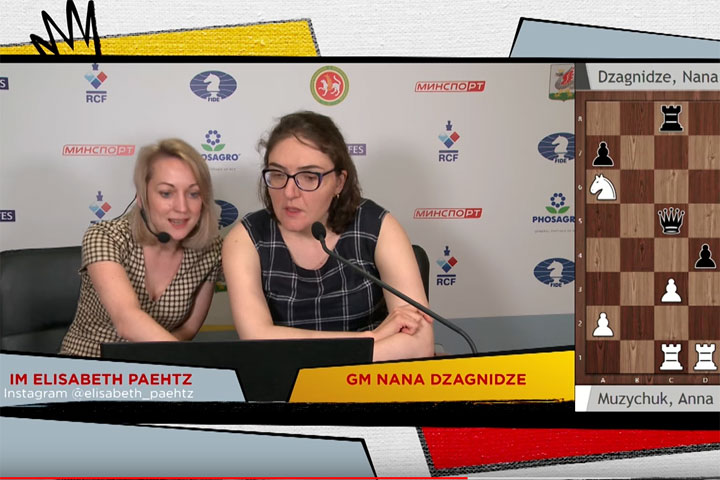
"And what would you have done if she had played Na6?" Elli and Nana doing analysis for the FIDE coverage of the 2019 Women's Candidates

Nana with her husband lasha and their sons Georg (5) and Nikoloz (7)
Mchadi with lobio and cheese
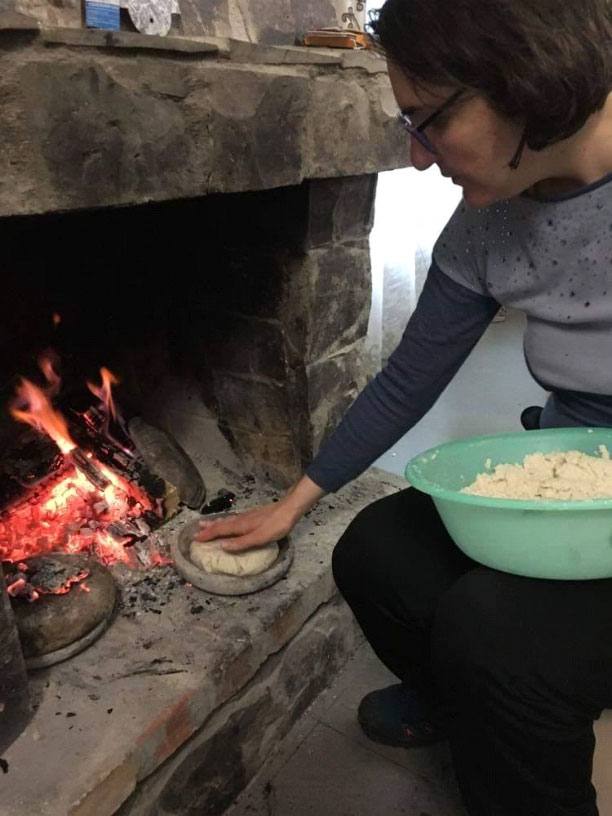 Interestingly when a while ago the most popular German chess magazine “Schach” asked a number of strong players the provocative question: “What would you do if there were no more chess in your life?” Nana was not worried at all. She said she would find some other occupation – perhaps, baker (why not?), and enjoy spending more time with her two little boys and family. Maybe lifetime happiness and no pressure is a great recipe for success.
Interestingly when a while ago the most popular German chess magazine “Schach” asked a number of strong players the provocative question: “What would you do if there were no more chess in your life?” Nana was not worried at all. She said she would find some other occupation – perhaps, baker (why not?), and enjoy spending more time with her two little boys and family. Maybe lifetime happiness and no pressure is a great recipe for success.
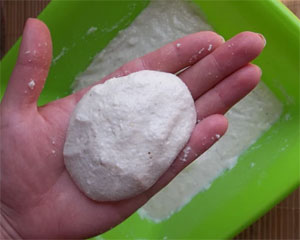
But what is she baking in this picture? It's Mchadi, a very popular cornbread, traditionally eaten with lobio (beans) and cheese. It is not complicated to make: 400 grams of stone-ground cornmeal (preferably white), 1/4 teaspoon of salt, 1 cup of cold water (may need more depending on the cornmeal). That's it. Add water to the cornmeal, little by little, so that the cornmeal becomes firm but not wet.
Heat the oil in a pan (medium heat) and add the dough. Smooth each piece with the back of a wet spoon. Cover and cook for 5-6 minutes. Turn the dough over and cook uncovered for a further 5-6 minutes. You can also roast them in front of a fire. The Mchadi are golden brown when ready.
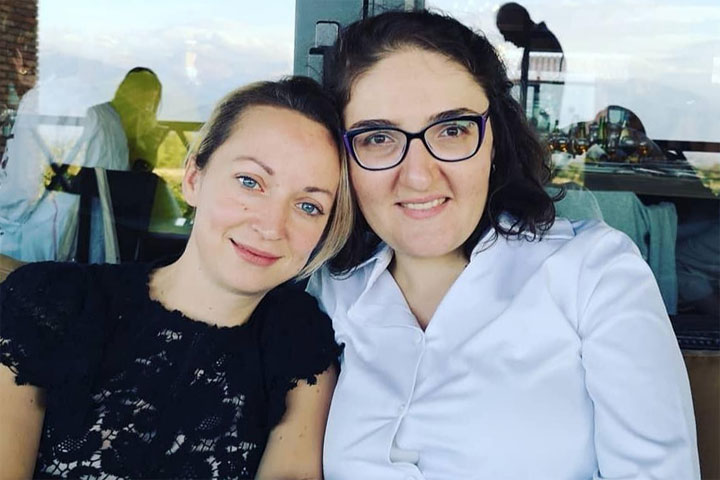


















 Nana was a New Year's child: she was born on January 1st 1987. Her father, a big chess fan, named her after the famous Georgian chess player
Nana was a New Year's child: she was born on January 1st 1987. Her father, a big chess fan, named her after the famous Georgian chess player 

 There is one more thing you can do. It is a lot of fun, but also a serious challenge: Click on the rook icon below the notation window. This will allow you the play the above position against Fritz, at your level of playing strength (e.g. "Club Player"), right here on the news page. Note that your analysis, in which you can delete, move or promote lines, is stored in the notation as new variations. In the end you will find the game with your analysis in the cloud. So nothing is ever lost,
There is one more thing you can do. It is a lot of fun, but also a serious challenge: Click on the rook icon below the notation window. This will allow you the play the above position against Fritz, at your level of playing strength (e.g. "Club Player"), right here on the news page. Note that your analysis, in which you can delete, move or promote lines, is stored in the notation as new variations. In the end you will find the game with your analysis in the cloud. So nothing is ever lost,

 Interestingly when a while ago the most popular German chess magazine “Schach” asked a number of strong players the provocative question: “What would you do if there were no more chess in your life?” Nana was not worried at all. She said she would find some other occupation – perhaps, baker (why not?), and enjoy spending more time with her two little boys and family. Maybe lifetime happiness and no pressure is a great recipe for success.
Interestingly when a while ago the most popular German chess magazine “Schach” asked a number of strong players the provocative question: “What would you do if there were no more chess in your life?” Nana was not worried at all. She said she would find some other occupation – perhaps, baker (why not?), and enjoy spending more time with her two little boys and family. Maybe lifetime happiness and no pressure is a great recipe for success.





